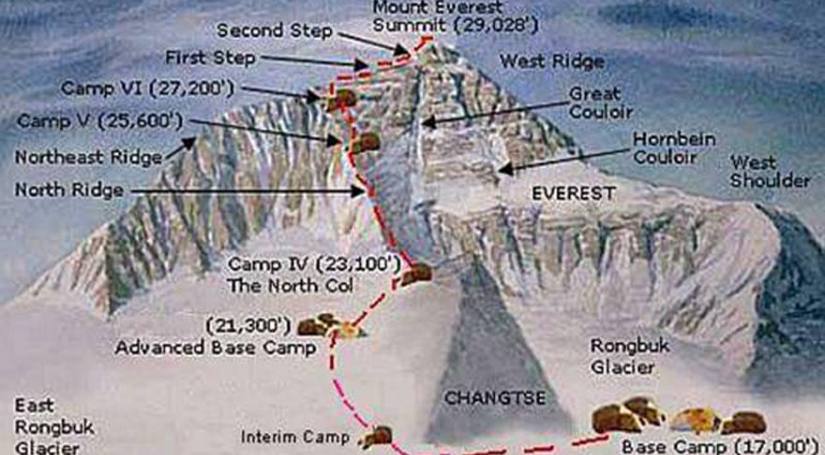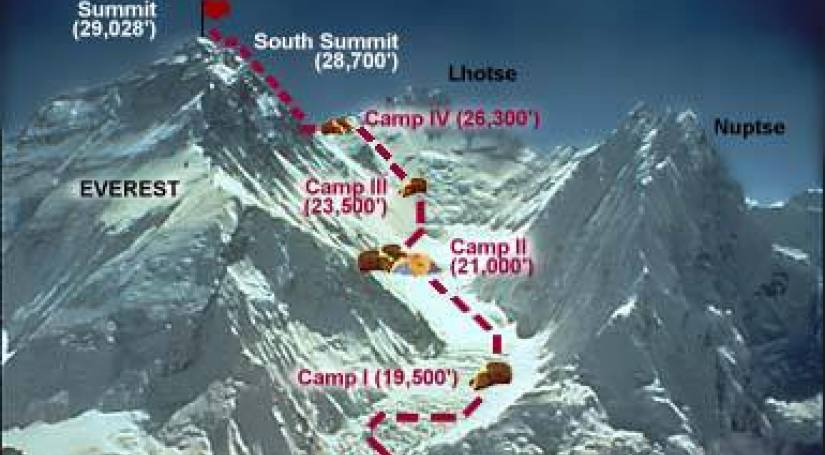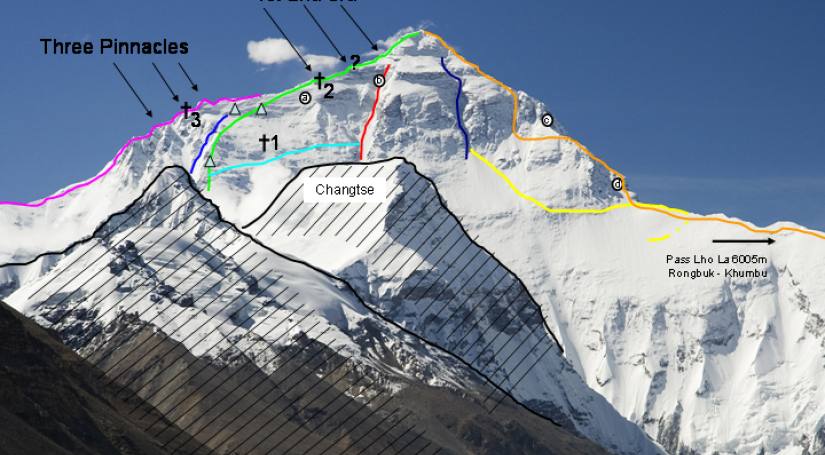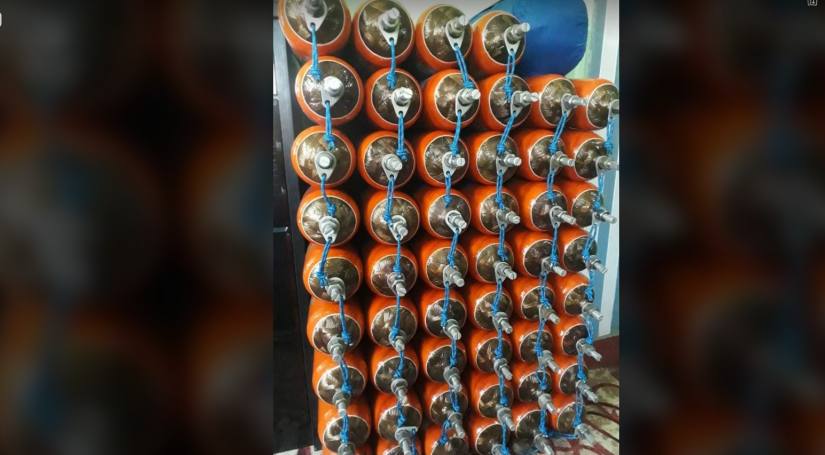Mt. Everest Expedition (60 days) Nepal South Side Full Board Services - 2025 Spring: April/May/June - 55 Days
-
Trip Code HTA-90
-
Duration: 55 Days
-
Trip Grade Strenuous
-
Trip Costs Starts From US$ 31,500.00
Trip Highlights
“We work with a mindset of making the clients very satisfied, happy as far as possible and Success is surely our major motive so we for the very purpose use very experienced helpful well English-speaking high-altitude climbing Sherpas (Summit-ed Mt. Everest multiple times and other several 8000m+). The president himself will be there for making the team happy and for the guidance of the whole team. We provide Nepali staffs who are highly qualified with lots of experiences. We do not have failure cases till date and we will not either let so happen.”
-Dawa Sherpa (+9779851016036, [email protected])
About Trip:
Climbing Mt. Everest is widely regarded as a pinnacle achievement in mountaineering. Each year, the mountain attracts approximately 1,000 summit attempts. Everest can be approached from both the southern route in Nepal and the northern route in Tibet. Following the Cultural Revolution in the 1950s, China closed Tibet’s borders to outsiders, while Nepal opened its doors to foreign climbers, making the southern approach through the Khumbu Valley increasingly popular.
The first successful ascent of Everest was achieved in 1953 by Tenzing Norgay Sherpa and Sir Edmund Hillary via the South Col. Climbing Everest is a once-in-a-lifetime experience, but expeditions face numerous challenges, including extreme altitude, severe weather, and physical exhaustion. For this reason, we prioritize safety and carefully plan each expedition to ensure the best possible experience for climbers.
Outline Itinerary
Cost Includes:
- Expedition permit fees for Everest and Lobuche East.
- 5 nights’ accommodations in Kathmandu with a bed and breakfast facility
- Flights from Kathmandu to Lukla and back including airport transfers
- All overnight accommodations while on the trek and climb
- Climbing equipment for the group like ropes, snow bar, ice screws, etc. which are necessary
- 5 oxygen bottles (each of 4 liters) per member and 3 oxygen bottles per sherpa; 1 bottle of oxygen lasts for 5/6 hours
- Liaison officer by government with his equipment, wages, insurance, and all his facilities
- Equipment transportation by yaks or porter and means of transportation (like helicopter etc.)
- Communication services i.e. walkie-talkie
- Services of kitchen, dining with tents which are required in the base camp, shower tents, toilet tents, heater, (per member tent till base camp and sharing above base camp) (cook service till base camp and camp 2)
- Insurance, equipment, rescue facility, and daily wages of sherpas and Nepalese kitchen staff with good experience cook with necessary Nepalese kitchen staffs.
- Set up regulator masks of high quality for members and Sherpas
- Helpful and Experienced Climbing Sherpas per member (at least summited Everest before including other mountains as well)
- Solar power
- Garbage Management: Stool Shipment Transfer and garbage Deposit fees.
- High foods above base camp and high cooking pots, EP gas, and other necessaries
Cost Excludes:
-
International airfare and Nepal Visa fee (bring accurate USD cash and one passport photographs)
-
Member personal equipment and extra services for members
-
Lunch and Dinner in Kathmandu
-
Emergency rescue if needed
-
Good Tips and Bonus for Staff and guide (1000 USD if summited bonus for your Sherpa)
-
Insurance and Trip cancellation
-
Medical things for members
-
Credit facility
-
Beverages
-
Personal expenses and more than mentioned in included.
Trip Map
Sightseeing and Preparation for the Everest Expedition: While the expedition leader attends a formal briefing at the Ministry of Tourism, participants have the opportunity to explore the vibrant city of Kathmandu. The day includes rest, orientation, and a guided tour of some of Kathmandu Valley’s UNESCO World Heritage Sites, including Kathmandu Durbar Square, Pashupatinath Temple, Swayambhunath (Monkey Temple), and Boudhanath Stupa.
This day is also dedicated to completing official procedures and finalizing necessary arrangements for the expedition. Participants will receive a briefing on the expedition’s objectives, equipment requirements, and team composition. It is also the perfect time to purchase any personal items needed before flying to the Himalayas the next day. In the late afternoon, the leader will inspect all equipment to ensure nothing essential is missing. Participants will be introduced to fellow expedition members and guides. The day concludes with a welcome dinner, offering an introduction to traditional Nepalese cuisine.
Overnight in Kathmandu.We spend the day in Namche Bazaar to rest and allow our bodies to acclimatize to the altitude of 3,450m (11,300 ft). Even on a leisure day, it is important to stay active, as health experts recommend light movement to aid acclimatization. Options for the day include taking a short hike to Thame, visiting Khunde, or exploring Namche Bazaar itself.
Namche Bazaar serves as the main hub of the Everest (Khumbu) region, featuring government offices, ATMs, internet cafes, shops, restaurants, a bakery, and a vibrant market held every Friday evening and Saturday. A small trek of a few hundred vertical feet during the day further supports acclimatization. Our guides may also take us to the Tourist Visitor Center near the Sagarmatha National Park headquarters, where we can learn about Sherpa culture, the first Everest ascenders, and the local flora and fauna. Overnight stay is in Namche Bazaar.
-Breakfast, Lunch & Dinner.An extra day is reserved to accommodate any unforeseen delays, such as flight cancellations or unfavorable weather, ensuring that the expedition stays on schedule and maximizes the chances of a successful climb.
Pre-Climb Training: During this day, our guides provide practical training in essential climbing techniques and the correct use of equipment, including ice axes, climbing boots, crampons, harnesses, and ascenders. Instruction also covers safe rope techniques for ascending and descending. This hands-on training is designed to build confidence, enhance climbing skills, and help participants fully enjoy the summit experience.
Day 13: Ascent to Lobuje high Camp (5,400m/17,712ft)From Lobuche, we trek toward Lobuche Base Camp. The initial part of the trail is relatively flat, but it becomes steeper and more rocky as we approach the base camp. The route follows the Lobuche Glacier, offering spectacular views of surrounding peaks such as Ama Dablam, Cholatse, Pokalde, Thamserku, Kantega, and other Himalayan giants.
From the base camp, the trail continues along a rocky moraine to reach the High Camp. Upon arrival, we set up camp, have lunch, and rest. The climb typically begins on rock surfaces up to around 5,770 meters, after which we transition to ice climbing, using ropes as necessary. The need for fixed or man ropes depends on seasonal conditions and the presence of crevasses. The climbing leaders make decisions on rope use to ensure safety. Overnight stay is at Lobuche East High Camp.
Day 14: Lobuje Summit (6,119m/20,070 ft) and back to base campWe begin the day with an early wake-up around 12–1 a.m. for breakfast before starting the climb. It is important to reach the summit before noon, as strong afternoon winds at high altitude can hinder progress. The ascent generally starts on rocky terrain up to approximately 5,700 meters, after which we switch to ice climbing. Both fixed ropes and man ropes are used according to the climbing leader’s instructions, with rope length and usage depending on seasonal conditions and the presence of crevasses.
Lobuche East offers some of the most panoramic views among trekking peaks. From the summit, climbers are rewarded with breathtaking vistas of Everest, Lhotse, Nuptse, Ama Dablam, Cholatse, Pumori, and other towering peaks. After celebrating and taking photos at the summit, we descend back to High Camp and continue down to Base Camp for an overnight stay.
(Note: The reason behind the lobuje ascent is to decrease the up and downs by the khumbu icefall as its abit risky there by doing the acclimatization in lobuje. If we don’t do the lobuje ascent then we from Everest base camp do the camp 1(18,300ft.) overnight then to reach camp 2(20,000ft) the other day, finally back the Everest base back which will be for the acclimatization. But incase lobuje is done then we do camp 1 overnight for a day, camp2 overnight 3/4 day... in which camp 3(21,300ft) touch is done then camp 2 overnight then camp 3 overnight. Finally, back base camp (This makes 1st course cleared) for the final summit target.)(Note: This is the biggest expeditions in Nepal and it is only organized for Spring. So the trip must be confirmed before 6 months for further bookings and paperwork which is a long process and we have to send the name list in Government system. A four-liter bottle of oxygen generally works for 5-6 hours. The faster the booking is done the better the services management can be done and is better so please book and confirm as soon as possible.)
You May Also Like
- Everest Base Camp Trek via Gokyo Lake 13th-September 2024(Full-Board)
- Lobuche East(6,119m/20,076ft.) Climbing With Everest Base Camp Trek Via Gokyo lake(Full-Board)
- Tibet (Kharta & Khangshung Valley) Trek with Everest Base Camp Trip 2025 (Full-Board Service)
- Chulu West with Annapurna Expedition
- UPPER MUSTANG TIJI Festival Trek 2025 April-27th (Full-Board)
- Mt. Him lung Himal (7,126m) Short Expedition-2024 (Full-Board) Service
- Pikey Peak with Everest Base Camp Trek Via Heli Ride- 2025 December-25th (New year Special)
- Mt. Everest Expedition-8848.86m (60 Days) Nepal South Side, Full-Board Services - 2026 April-05th
- Mt. Everest Expedition Nepal South Side & Lhotse- Full Board Services(April-5th)
- Island peak Climbing With Everest Base Camp Trek
- Himlung Himal Expedition
- Mt. Manaslu Expedition August-29th(Full-board)
- Mera Peak Climbing via Phaplu
- (Christmas & New Year’s Special 2025 December -22) - Covering All World Heritage Sites (City Tour Program- (Full-board) & Mountain Flight to Everest Region.)
- Pikey Peak Trail-2026 Christmas and New Year’s Special (Full Board)
- UPPER MUSTANG TREK 2025 May 5th
- UPPER MUSTANG OVERLAND TIJI TOUR 2025 May 04th (FULL-BOARD SERVICE)
- Mt. Amadablam Expedition
Trek to Langtang
We first met Dorjee Sherpa in 2012 and did a trek with him to Langtang before it was devastated in the earthquake. We quickly fell in love with the himalayas, the Nepalese people, their culture, and Dorjee shepa. The Langtang trek was a beautiful trek and a great introductory to the…
 Matt massey, United StatesDecember 22, 2025
Matt massey, United StatesDecember 22, 2025
Trek to Tyangboche
Just got home from our second trek in the Himalayas with Dorjee sherpa. We treked to tengboche for the mani rimdu festival. The festival was incredible and the mountains are magnificent. Dorjee is a great guide and we really enjoyed staying at his Buddha lodge and meeting his wonderful family.
 Matt massey, United StatesDecember 22, 2025
Matt massey, United StatesDecember 22, 2025
Mani Rimdu Festival trek
My family and friends from Maui completed a 10 day trek through Sagarmatha National Park to Tengboche to view the Mani Rimdu Festival in November . Our Guide Dorjee Sherpa and his associates arranged a fantastic trip for us. We stayed at his Buddha Lodge in Phakding and were treated very…
 Kevin Horan, NepalDecember 22, 2025
Kevin Horan, NepalDecember 22, 2025
Have fun with trust!
I spent very memorable days in the Everest region in Nepal. I used to dream to see this highest peak of the world and now I arrested it in my camera. My guide arranged everything and helped me a lot. He did not let me feel tired and boring.
 Austin, Netherlands AntillesDecember 22, 2025
Austin, Netherlands AntillesDecember 22, 2025
Certificate & Partners











